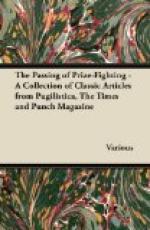ANNA PAVLOVA.
She hasn’t changed at all. Many Russian dancers have come and gone since last she was with us, but there is still none like her, none. Her perfect technique remains the least of her graces. The secret of her charm lies deeper, in the power to interpret and convey emotions in the language of her art. To watch her feet alone is to hear the shuddering sigh of her Dying Swan, but her whole body is alert to translate every nuance of her theme.
She can draw beauty even from an anticlimax. Again and again in Snowflakes, when her partner withdrew the support of his hand, she poised for a moment, and, when the poise had to cease, covered her descent with the most fascinating gestures of head and arms.
I liked her least (if one may talk of her like that) as the gipsy-girl in Amarilla; not that she failed in dramatic intensity but that jealous passion seems alien to her temperament as we have learned to know it. I think, however, that my judgment was tainted by her wig, which greatly distressed me.
In M. VOLININE she has a very accomplished partner. His solo as a Pierrot, danced to a familiar air of DVORAK’S, was the most delightful of “divertissements.” Her other dancers, Russian and English, make up a really excellent company. The presto furioso of the wild gipsy dance in Amarilla, to the exciting music of GLOZOUNOW and DRIGO, was a brilliant tour de force.
My only complaint (apart from Amarilla’s wig) is that the programme’s explanation of the motive of Snowflakes was beyond me. “A little girl,” it says, “receives as a present a nut-cracker in the form of a doll. The doll is in reality a Prince who has been transformed by a bad fairy, but by an act of devotion to the little girl he is restored to life. He then leads his little friend and other children to the Kingdom of Pine-trees where the Christmas-tree was born.” It is true that the music was from TSCHAIKOWSKI’S “Casse-Noisettes,” and that the snow-scene was suggestive of Christmas-time; but there was no sign of a “nut-cracker in the form of a doll,” or, if there was, I can’t think how it escaped me, for I was watching with all my eyes.
O.S.
* * * * *
[Illustration: THE LANGUAGE OF LOVE.
Schoolboy (after long pause). “I SAY—ER—CAN YOU MOVE YOUR EARS?”]
* * * * *
“Chaplain-Master Wanted
on May 13th for one term to Teach Latin and
History in Upper School, coloris
paribus a cricketer would be most
acceptable.”—Provincial
Paper.
“Coloris paribus” suggests faintly that the authorities hope to get a double-blue; but it looks as if he would have to spend most of the term in teaching Latin.
* * * * *
BIRD CALLS.




